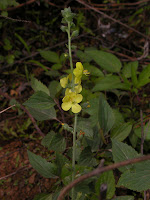



FAMILY OF THE WEEK: SOLANACEAE (NIGHTSHADE FAMILY)
A large family with over 2000 species worldwide. In India there are 15 genera and 88 species. Many species are cultivated while others occur chiefly in Himalayas and southern and eastern parts of India.
Vegetative characters:
They are mostly annual or perennial herbs, sometimes shrubs or small trees and rarely climbers. The stems are prickly or spinous, the spines are modified branches. The vascular bundles are bicollateral. Underground tubers are found in Solanum tuberosum. The leaves are alternate,exstipulate, simple,entire, lobed or pinnatified. In the inflorescence portion the leaves often become subopposite or opposite.
Inflorescence and flowers:
Often cymes which are lateral, axillary or terminal. In some species of Solanum they are extraaxillary appearing to arise from the middle of an internode. Very frequently they are solitary and axillary as in Datura and Nicardia and rarely clustered as in Withania. The bracts and bracteoles are absent.
The flowers are actinomorphic or sometimes zygomorphic, bisexual, pentamerous and hypogynous. The calyx is five lobed or five partite and usually persistent and much enlarged in fruit. The corolla is gamopetalous and funnell shaped(Datura) campanuloate(Physalis) or rotate(Solanum) The limb is usually five lobed or rarely ten lobed as in Datura and the lobes are folded contorted or valvate. The stamens are usually five,epipetalous on the corolla tube and alternate with the lobes. They are commonly of unequal heights. The anthers are ovate or oblong, sometimes connivant into a cone as in Solanum, dithecous,introrse and dehiscing by longitudinal slits or by apical pores.(Solanum)
Thhe gynoecium is typically bicarpellary and syncarpous. The ovary is superior and bilocular with axile placentation.The style is linear and the stigma is capitate or shortly lobed.
A hypogynous nectariferous disc is usually present at the base of the ovary.
Fruits and seeds:
The fruit is a berry which is sometimes (Physalis)enclosed within an inflated bladder-like calyx or capsule. The seeds are numerous, compressed, discoid or subreniform, endospermic and with a curved or straight embryo.
Pollination and dispersal:
Conspicuous flowers and nectariferous disc favor insect pollination. Solanum tuberosum is devoid of nectar and is scarcely visited by insects. Here usually self pollination occurs by the style curving backwards to touch the anthers.
The seeds are usually dispersed by birds and animals.Species of Datura,Atropa and Hyoscyamus are dispersed by water.
Examples:
Solanum tuberosum (Potato, Batata)
Solanum melongena (Egg plant,Brinjal,Baingan,Wang) Lycopersicon esculentum(Tomato)
Capsicum annuum (Chillies, Mirch)
Nicotiana tobacum (Tobacco)
Atropa belladonna(Belladonna)
Hyoscymus niger
Datura stramonium
Withania somnifera (Ashwagandha)
Withania coagulans (Indian rennett)
Petunia









